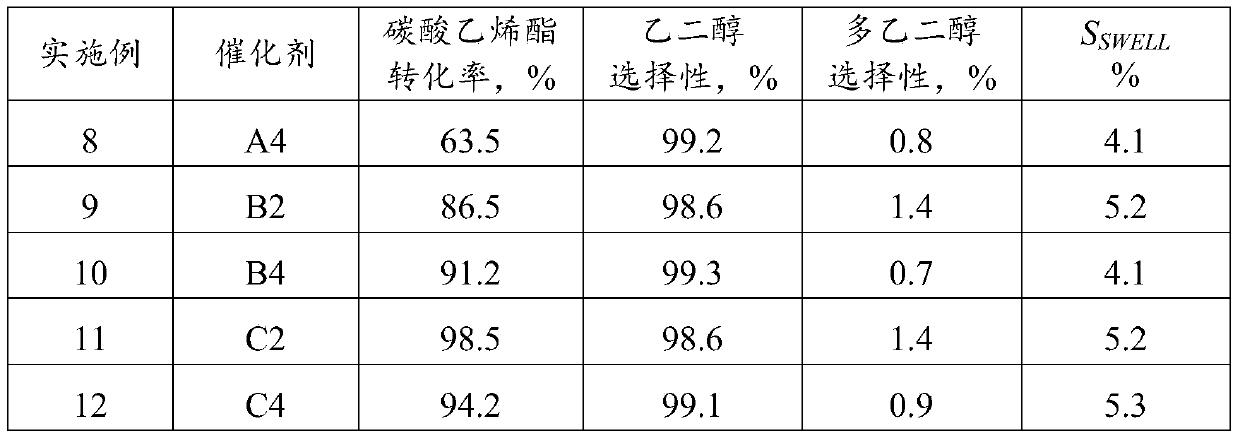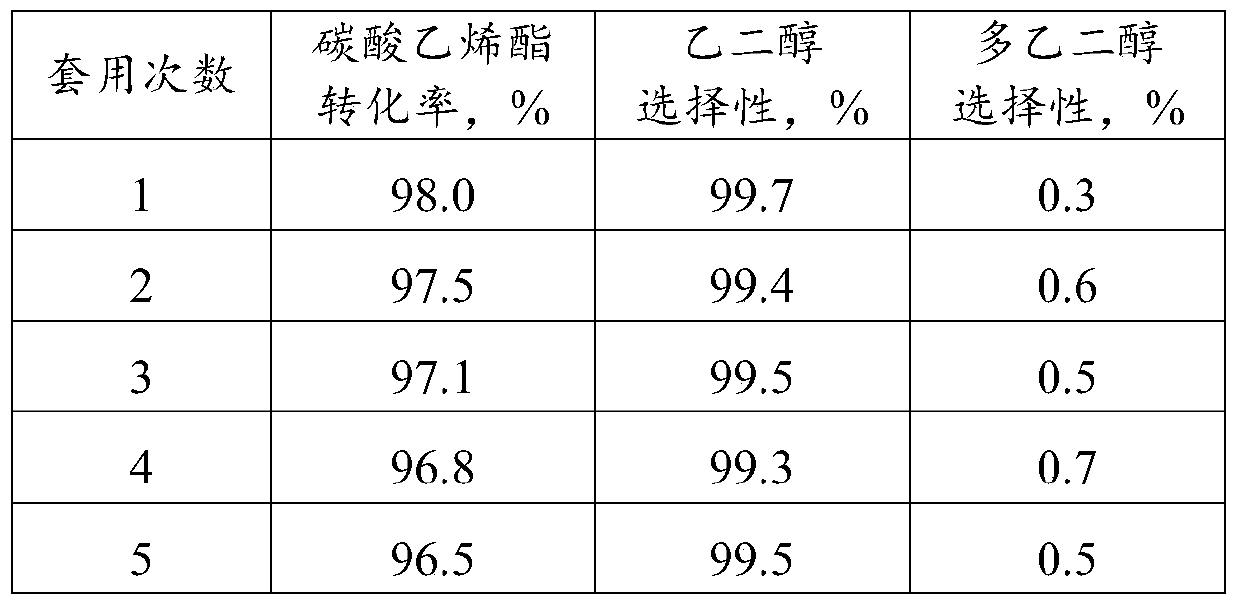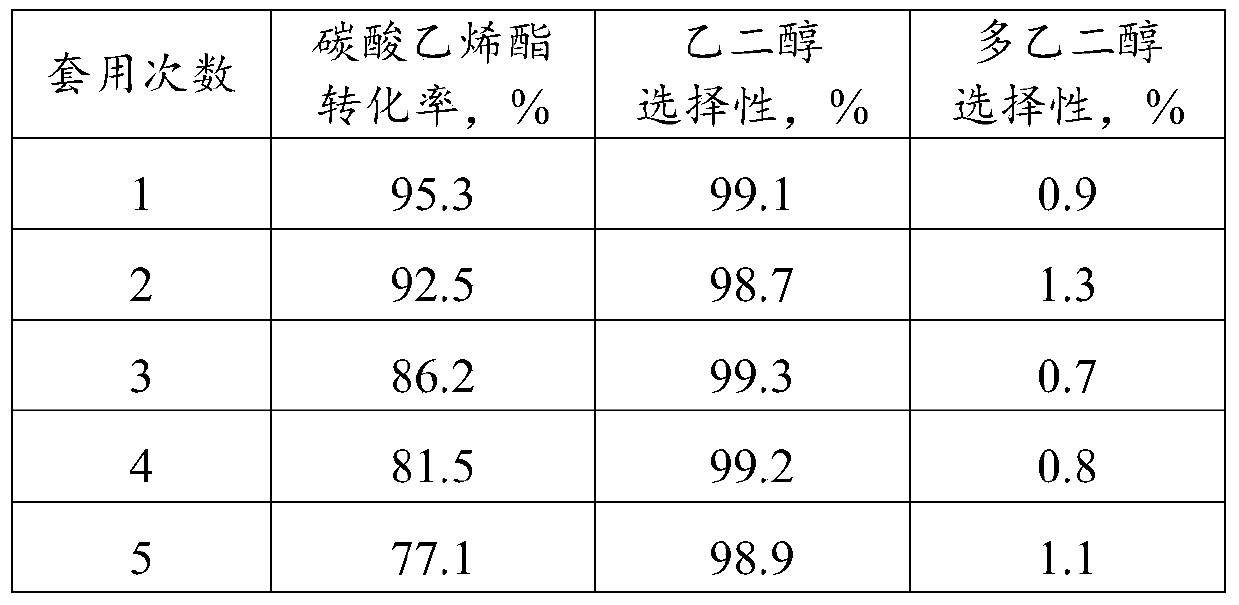Method for production of ethylene glycol by hydrolysis of ethylene carbonate
A technology for ethylene carbonate and ethylene glycol, which is applied in the field of ethylene carbonate hydrolysis to produce ethylene glycol, can solve the problems of rapid decline in activity, easy swelling, low temperature resistance of resin catalysts, etc., so as to improve catalytic activity and enhance swelling resistance. Effect
- Summary
- Abstract
- Description
- Claims
- Application Information
AI Technical Summary
Problems solved by technology
Method used
Image
Examples
Embodiment 1
[0032] Add 58.0 grams of styrene, 0.6 grams of divinylbenzene, 30 grams of polystyrene and 0.6 grams of benzoyl peroxide initiator in a 500 milliliter three-necked flask, and stir for 2.0 hours at 60°C; then add 2.8 grams of multi-walled carbon Nanotubes, continue stirring for 1 hour for pre-polymerization. 260 mL of deionized water in which 2.5 g of polyvinyl alcohol had been dissolved was added. Adjust the stirring speed, while gradually raising the temperature to 80°C, and react for 5 hours; then raise the temperature to 90°C, react for 5 hours, and finally raise the temperature to 98°C, and react for 6 hours. After the reaction, pour out the upper liquid, wash with 85°C hot water, then wash with cold water, then filter, put in an oven to dry at 80°C, sieve, and collect composite microspheres with a particle size within the range of 0.35 to 0.60 mm a.
[0033] Chloromethylation of composite microspheres: In a 500-ml three-necked flask, add 50 grams of composite microspher...
Embodiment 2
[0038] The synthesis process of the composite microsphere and the composite chlorine sphere is the same as [Example 1].
[0039] Synthesis of carboxyimidazole: In a 500 ml three-necked flask, add 20 g of imidazole, 41.5 g of bromoacetic acid and 120 ml of acetonitrile, and react under reflux for 30 hours. After the reaction, evaporate the solvent to obtain carboxy imidazole S2.
[0040] Synthesis of composite carboxylimidazole resin: add 20 grams of composite microspheres, 38 grams of carboxylimidazole S2 and 120 milliliters of toluene in a 500 three-necked flask, stir and react under reflux for 30 hours, filter and remove the mother liquor after the reaction, and use dichloro Wash with methane, acetone and water, and dry under vacuum to obtain composite carboxylimidazole resin A3.
[0041] Exchange of composite carboxylimidazole resin: In a 200 ml beaker, add 10 grams of composite carboxylimidazole resin A1, 10 grams of KHCO 3 And 120 grams of deionized water, after stirring...
Embodiment 3
[0043] Add monomer mixture solution (60.0 gram styrene, 1.7 gram divinylbenzene, 60 gram polystyrene, 1.6 gram multi-walled carbon nanotube and 1.0 gram benzoyl peroxide containing initiator in 500 milliliters of three-necked flasks, The solution was first stirred and reacted at 70°C for 0.5 hours), started the agitator, added a mixed solution of 200 milliliters of deionized water and 5 grams of gelatin, raised the temperature to 85°C, reacted for 3 hours, then raised the temperature to 90°C, reacted for 9 hours, and finally The temperature was raised to 100° C., and the reaction was carried out for 10 hours. After the reaction, pour out the upper liquid, wash with 85°C hot water, then wash with cold water, then filter, put in an oven to dry at 80°C, sieve, and collect composite microspheres with a particle size within the range of 0.35 to 0.60 mm b.
[0044] Chloromethylation of composite microspheres: In a 500-ml three-necked flask, add 50 grams of composite microspheres B ...
PUM
 Login to View More
Login to View More Abstract
Description
Claims
Application Information
 Login to View More
Login to View More - R&D Engineer
- R&D Manager
- IP Professional
- Industry Leading Data Capabilities
- Powerful AI technology
- Patent DNA Extraction
Browse by: Latest US Patents, China's latest patents, Technical Efficacy Thesaurus, Application Domain, Technology Topic, Popular Technical Reports.
© 2024 PatSnap. All rights reserved.Legal|Privacy policy|Modern Slavery Act Transparency Statement|Sitemap|About US| Contact US: help@patsnap.com










